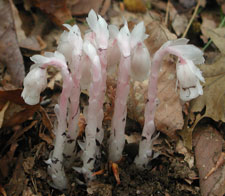Resource Library
Plant of the Week: Indian Pipe
The University of Arkansas System Division of Agriculture does not promote, support or recommend plants featured in "Plant of the Week." Please consult your local Extension office for plants suitable for your region.
Plant of the Week
Indian Pipe
Latin: Monotropa uniflora

We all know how plants are supposed to behave but, apparently, some never got the memo. Variation in environmental requirements and form are commonplace but some even go so far as to change their way of obtaining food. Indian pipe (Monotropa uniflora), for example, has foregone photosynthesis and lives by thievery.
Indian pipe is an herbaceous woodland wildflower of the eastern deciduous forest of the United States and Canada with a tremendous range of distribution. In addition to our neck of the woods, it’s also found in high, cool mountains of Central America and northern parts of South America, Japan, China, the Himalayas of southern Asia and India.
It has a wider range of distribution than almost any modern plant, indicating it probably evolved during the Jurassic period during the peak of the dinosaur era before the supercontinent of Laurasia separated. It belongs to its own family, the Monotropaceae, but is closely allied with the azalea family and some authorities place it there.
Indian pipe grows 6-to 8-inches tall. It’s an unbranched plant with a solitary nodding flower that pushes through the soil with its crooked flower already formed. Usually several stems arise from an underground crown.
The stem, the scale-like leaves and the flower itself are waxy, extremely fragile and white or sparingly infused with pink. Because of its lack of chlorophyll, it’s sometimes called ghost plant or corpse plant.
The single five-petal flower is to an inch long. When the bloom is pollinated, it rotates upward and the seed capsule matures in an upright position. The stems turn black as they die. Flowers appear in late summer and fall following a soaking rain.
Indian pipe derives its carbon stores, not from photosynthesis, but by stealing them from a mycorrhizal fungus living in the root zone of the forest. Mycorrhizal fungi are beneficial (symbiotic) organisms that vastly expand the absorptive surface area of a tree’s root system and aid in uptake of specific nutrients such as phosphorus. In exchange for scavenging for nutrients the tree reciprocates by providing carbohydrates for the fungus.
Germinating seedlings of Indian pipe chemically mimic the tree’s root system causing the mycorrhizal fungi to attach to the roots of the imposter in a kind of biological identity theft. The tree sends its sugars produced in photosynthesis to the fungus mycelium which in tern passes some along to the thieving Indian pipe. This arrangement is called epiparasitism.
Indian pipe is only able to feed on one group of mycorrhizal fungi, the Russula. These beneficial fungi are able to attach to a wide variety of tree species including oaks and beech. Cool, moist and shaded conditions favoring the accumulation of thick deposits of leaf litter favor the development of the mycorrhizal fungus and mark the kind of location where Indian pipe is likely to grow.
Though an interesting and relatively rare native Arkansas wildflower, Indian pipe will never be grown in the garden. Its specific requirements and epiparasitic ways make it all but impossible to cultivate.
By: Gerald Klingaman, retired
Extension Horticulturist - Ornamentals
Extension News - January 12, 2007
The University of Arkansas System Division of Agriculture does not maintain lists of retail outlets where these plants can be purchased. Please check your local nursery or other retail outlets to ask about the availability of these plants for your growing area.